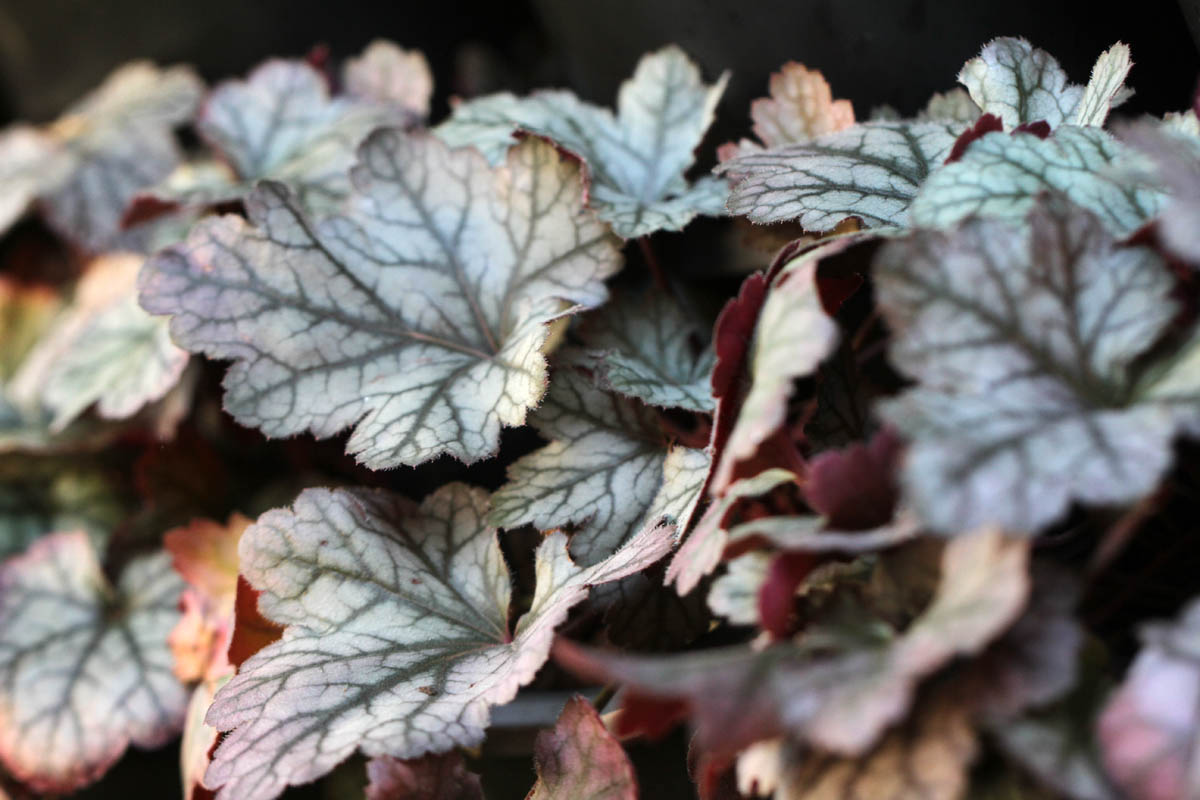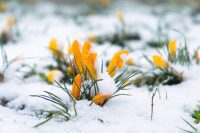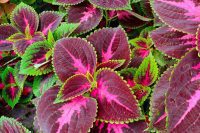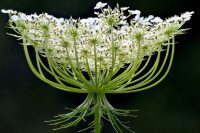What is Heuchera? Ι Appearance Ι Native habitat Ι How does Heuchera get its colourful leaves? Ι Planting and care Ι Uses Ι Propagation Ι Toxicity
At a glance
| Family: Saxifragaceae |
| Botanical name: Heuchera species |
| Native to: The Americas |
| Common names: Heuchera, Coral bells, Alumroot, |
| Lifespan: Evergreen tree |
| Mature height: 30 – 45 cm |
| Type of plant: Herbaceous perennial |
| Flower colour: White, greenish-white, cream, pink, fuchsia, coral, red |
| Leaf colour: Green, caramel, orange, red, silver, purple, silver, variegated |
| Stem colour: Green, red, burgundy, purple, bronze |
| Bloom time: Early summer |
| Soil: Well-draining, fertile, and humus-rich soil |
| Humidity: Low |
| Propagation: Cuttings, division, seeds |
| Care level: Easy |
What is Heuchera?
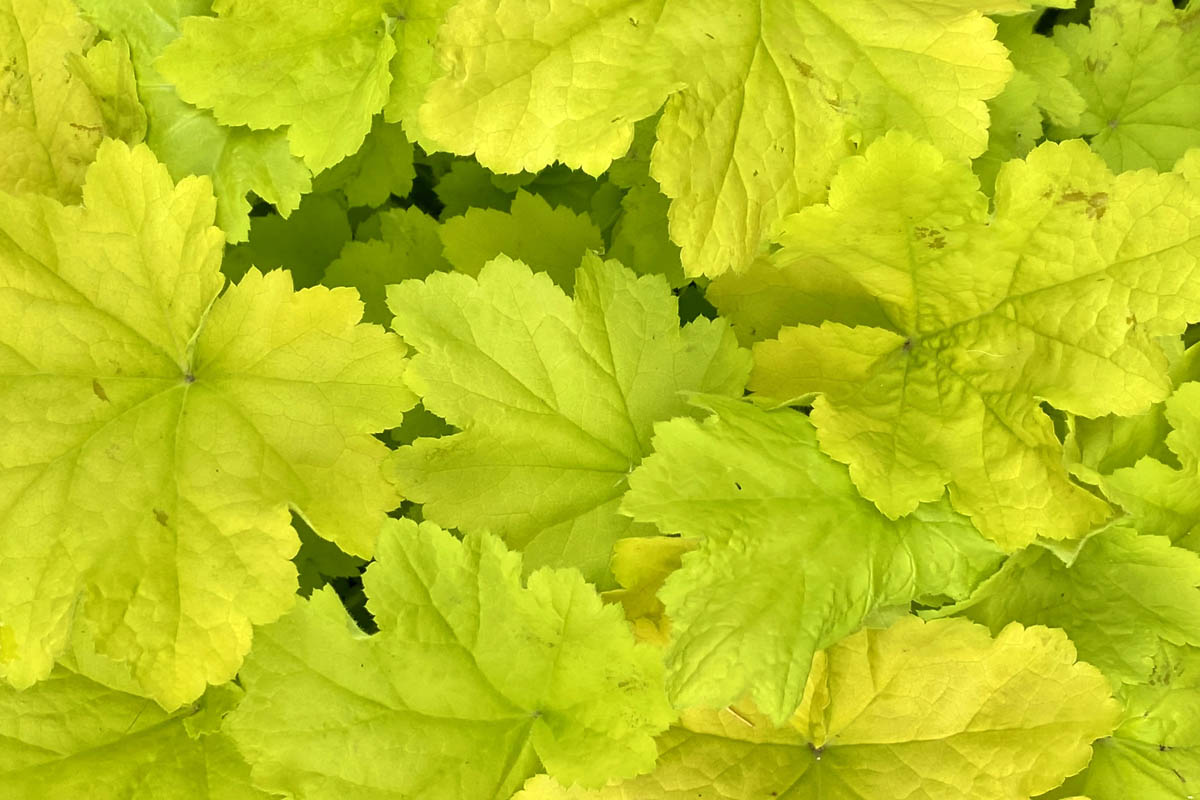
Also known as coral bells, rock geranium or alumroot, Heuchera spp. (pronounced HUGH-ker-ah) is a clump-forming, herbaceous evergreen or semi-evergreen member of the Saxifragaceae family. It is native to Northern USA and Mexico and consists of 55 species and dozens of cultivars. Heuchera is widely grown in gardens for its attractive ruffled, colourful foliage and delicate bell-shaped flowers which grow on long spikes. The foliage is found in a wide variety of colours including green, red, champagne, purple, orange, apricot, bronze and silver with contrasting veins.
Closely related is Heucherella, a hybrid of Heuchera and Tiarella (foam flower). Heucherella has traits from both parents, with the attractive and colourful foliage of Heuchella along with the delicate, foam-like flowers of Tiarella.
Heuchera was first described by Swedish botanist and father of modern taxonomy Carl Linnaeus in 1753 in his work ‘Species Plantarum.’ Carl Linnaeus named Heuchera in honour of Johann Heinrich von Heucher (1677 – 1746), an Austrian physician, botanist and professor of medicine at the University of Wittenberg. Heucher was a prominent figure in the field of botany during his time, having contributed to the founding of the Wittenberg Botanical Garden.
While the name ‘coral bells‘ is frequently used for all Heuchera species, it actually refers specifically to H. sanguinea, a species with bright green leaves and red flowers. Sanguinea gets its name from the Latin word ‘sanguineus,’ which means ‘blood-red‘, in reference to its flowers.
Appearance
Heuchera grows in a clump, with a crown just at soil level, where new leaves emerge. The crown is the area where the stems and leaves emerge from the root system, and it is also where new roots and shoots develop. Heuchera leaves are typically arranged in a basal rosette around the crown, and the foliage can vary widely in colour, texture, and shape depending on the cultivar. During frost, crown heaving can occur, due to the soil freezing and thawing, which causes it to expand and contract. This can push the crown of the plant upwards above the soil line. Heuchera leaf colour can change over time. Immature leaves of some varieties can fade as they mature, green Heuchera often have silvery veins which fade by autumn.
Leaves:
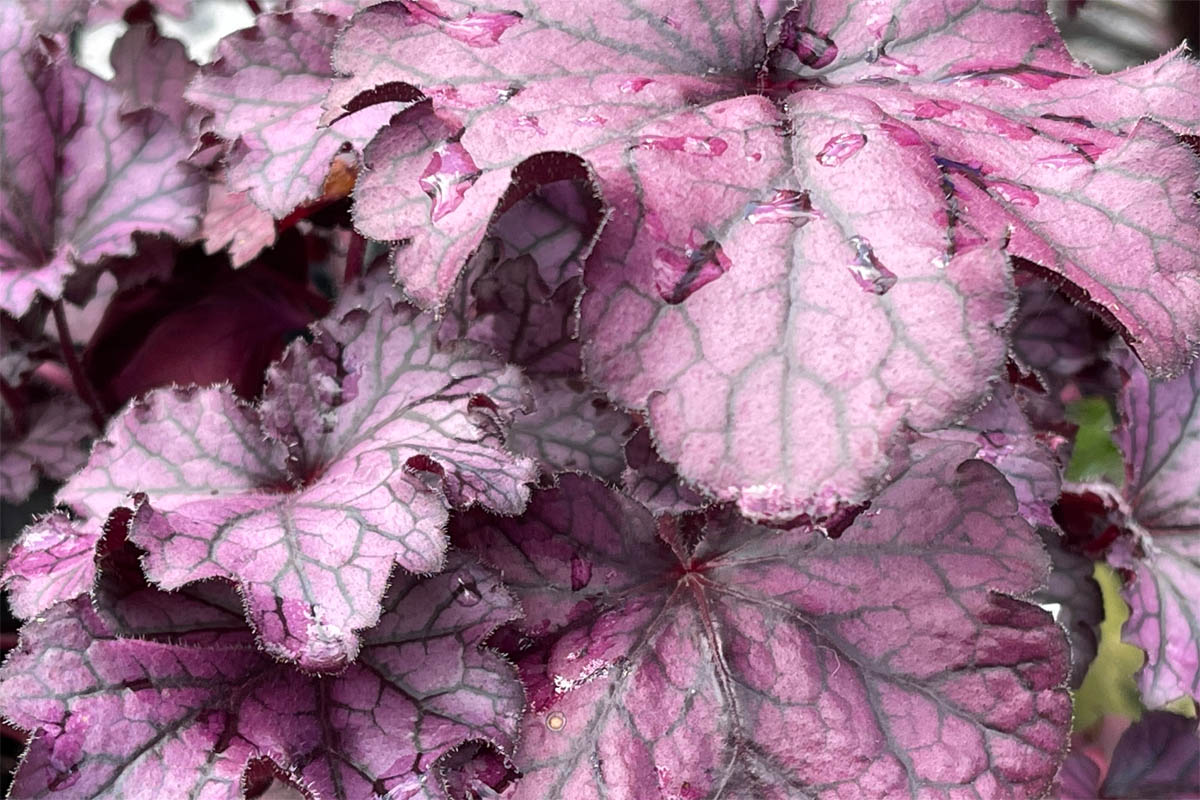
The leaves are rounded to heart-shaped with lobed or scalloped edges and can vary in size from small to large, depending on the species or cultivar. The leaf surface can be smooth, veined, or slightly hairy, further adding textural interest to the garden. Heuchera leaves boast an impressive range of colours, from vibrant greens and deep purples to warm oranges and rich reds, often exhibiting intricate patterns or marbling. This diverse foliage remains evergreen in milder climates, providing year-round interest and making Heuchera an attractive addition to any garden.
Leaf colours:
Green
|
Purple/Black
|
Silver
|
Caramel
|
Yellow/orange/brown
|
Red
|
Flowers:
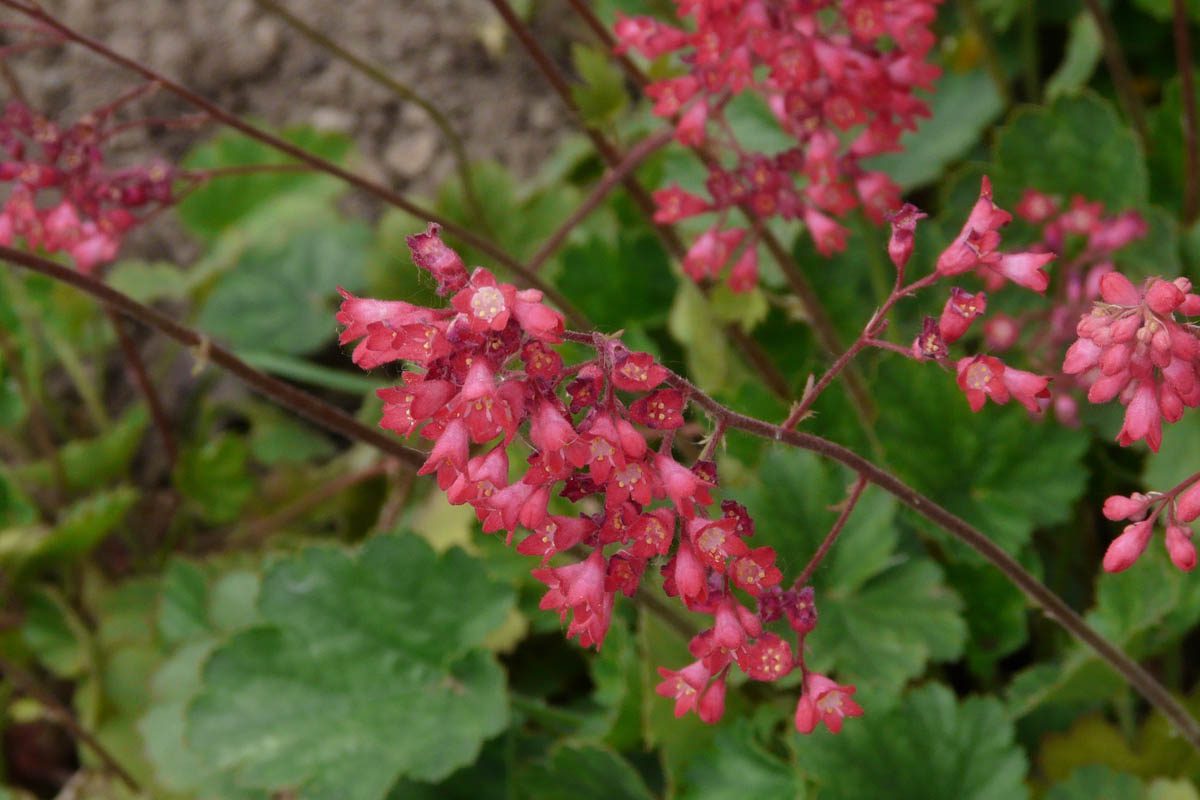
The delicate, bell-shaped flowers grow on slender, upright stems above the plant’s mound. Heuchera flowers come in white, pink, red or coral, and appear in loose racemes. The bloom period is from late spring to early summer and sometimes extends into autumn. When planted en masse, Heuchera flowers create an airy effect that compliments the vibrant colours of the foliage.
Native habitat
Heuchera grows in various habitats including woodlands, forests, alpine meadows, cliffs, canyons and rocky slopes. They are well-adapted to various conditions from shady moist areas to sunny, dry and well-drained rock crevices. The growth habitat varies between species and extends from British Columbia down to Mexico.
Cultivated Heuchera can grow in pots or in the ground, under trees, and in full sun. This versatile little plant has so many uses.
Distribution:
- H. americana (American alumroot): A woodland species native to the eastern United States, from New York to Georgia, and westward to Oklahoma and Minnesota.
- H. micrantha (small-flowered alumroot or crevice alumroot): Western United States, especially California and Oregon.
- H. cylindrica (Roundleaf alumroot): British Columbia, south down to California and east to Nevada, Wyoming and Montana.
- Heuchera villosa (hairy alumroot): Southeastern United States, particularly in the Appalachian Mountains.
- Heuchera glabra (smooth alumroot): Western United States and western Canada, from southern British Columbia to California and eastward to Montana and Colorado.
- H. sanguinea (coral bells): Arizona and New Mexico to northern Mexico.
- Heuchera richardsonii (Richardson’s alumroot): Great Lakes region down to the central Midwest, including states like Minnesota, Wisconsin, Illinois, Michigan, and Iowa.
- H. longiflora (long-flowered alumroot): The Appalachian Mountains, including the states of Virginia, North Carolina, South Carolina, Georgia, and Tennessee.
How does Heuchera get its colourful leaves?
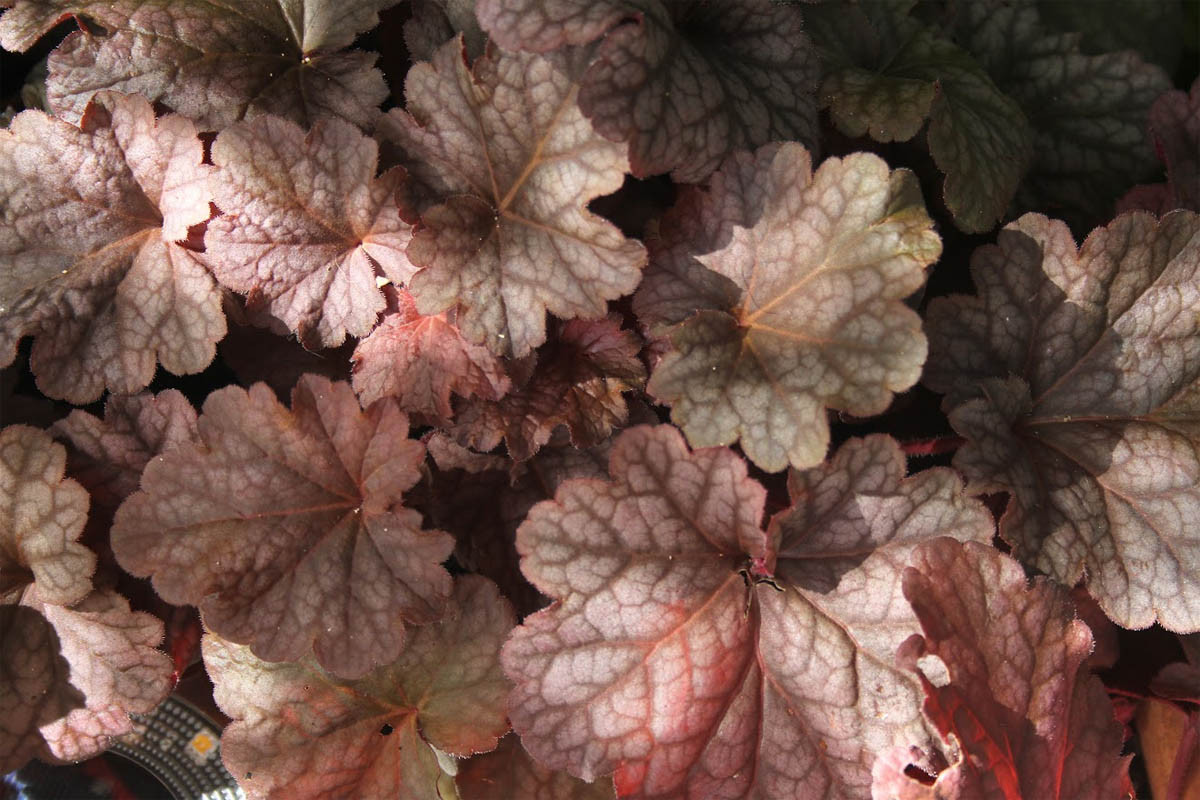
Heuchera exhibits a diverse range of colourful foliage due to genetics, hybridisation and natural variation within the genus. The pigments responsible are primarily chlorophyll, carotenoids and anthocyanins.
- Chlorophyll: The most abundant pigment in plants which gives them their characteristic green colour. Chlorophyll is synthesised in plant cells known as ‘chloroplasts‘, and plays a critical role in photosynthesis, the process in which plants convert sunlight to energy.
- Carotenoids: These pigments are responsible for yellow orange and red hues and are synthesised in the plastids of plant cells, which include chloroplasts, chromoplasts and leucoplasts. Carotenoids are also found in flowers and fruits of other plants such as marigolds, nasturtium, California poppy, zinnia, carrot, pumpkin, tomato and bell pepper. Carotenoids play a role in photosynthesis and provide antioxidant protection.
- Anthocyanins: These pigments are responsible for the red, blue and purple shades. Anthocyanins are water-soluble and found in the cell vacuoles. They provide antioxidant protection and help protect the plant from ultraviolet radiation, temperature fluctuations and drought.
We shouldn’t forget the beautiful bell-shaped flowers which grow on long, elegant stems. Flower colours include white, pink, fuscia.
Planting and care
Heuchera is an undemanding plant that thrives in a range of locations from part shade to full sun. However, if you live in a temperate to tropical environment, avoid full afternoon sun which can scorch the plant. Heuchera cultivars with darker foliage are usually better at tolerating sunnier conditions than those with lighter-coloured leaves. The pigments responsible for the darker colouration help protect the leaves from damage caused by the sun’s rays. Ensure your Heuchera does not dry out when grown in full sun. Unlike Coleus spp., another ornamental plant grown for its colourful foliage, many Heuchera are frost-hardy.
Heat tolerant Heuchera
For those in warmer climates, cultivars from H. villosa, H. sanguine and H. richarsonii are more heat tolerant than those from H. micrantha.
- Heuchera ‘Caramel’
- Heuchera ‘Autumn Bride’
- Heuchera ‘Georgia Peach’
- Heuchera ‘Citronelle’
- Heuchera ‘Bronze Wave’
- Heuchera ‘Southern Comfort.’
Frost tolerant Heuchera
Add a layer of mulch around the base of your Heuchera to help protect the roots from freezing. Use a 5 cm layer of organic mulch (my personal choice is sugar cane mulch).
- Heuchera ‘Palace Purple’
- Heuchera ‘Caramel’
- Heuchera ‘Snow Angel’
- Heuchera ‘Green Spice’
| Light | Partial shade to dappled sunlight; can tolerate some morning sun. Avoid excessive direct sunlight. |
| Soil | Well-draining, fertile, and humus-rich soil. Prefers slightly acidic to neutral pH (6.0-7.0). Avoid heavy, waterlogged or clay soil. |
| Plant spacing | 30 – 45 cm apart. |
| Watering | Consistent moisture; avoid overwatering or allowing the soil to dry out completely. |
| Fertilising | Apply a balanced, slow-release fertilizer in spring, or use compost or well-rotted manure. |
| Mulching | Apply a layer of organic mulch to help conserve moisture and regulate soil temperature. |
| Pruning and deadheading | Remove spent flowers and dead or damaged leaves. Trim back older leaves in late winter or early spring to encourage new growth. |
| Pests and diseases | Watch for pests like aphids, whiteflies, and spider mites. Diseases include powdery mildew, rust, and leaf spot. Maintain good air circulation and avoid overhead. |
| Zones | Generally hardy in USDA Zones 4-9, depending on the cultivar. |
Planting guide:
- If planting in the ground, dig a hole twice as wide as the plant.
- Gently remove the plant from its pot and tease the roots if they are potbound.
- Place the plant into the hole and backfill with soil, press down gently.
- Water in well after planting, a seaweed tonic such as Seasol can help reduce transplant shock.
- Mulch around the plant to help retain moisture.
- Plant 30 – 45 cm apart.
How to pot a Heuchera
- Select a pot that is 5 cm wider than the plant.
- Place a small amount of premium potting mix into the pot.
- Carefully remove the Heuchera from its pot and tease the roots apart if it is potbound.
- Place the plant into the pot, ensuring that the soil is 2 cm below the rim of the pot. Gently firm down.
- Water in well, and add a small amount of Seasol (optional).
- Add some mulch around the base of the pot.
How long does Heuchera live?
The one downside to these beautiful and colourful plants is their short lifespan of 3 – 4 years. As the crown becomes woody, the plant’s growth and vigour can decrease. Woody crowns limit the plant’s ability to produce new, healthy foliage, leading to a decline in the overall health and appearance of the plant. Dividing the plant can help extend the lifespan of your Heuchera, this should be carried out in spring, as active growth commences.
Uses
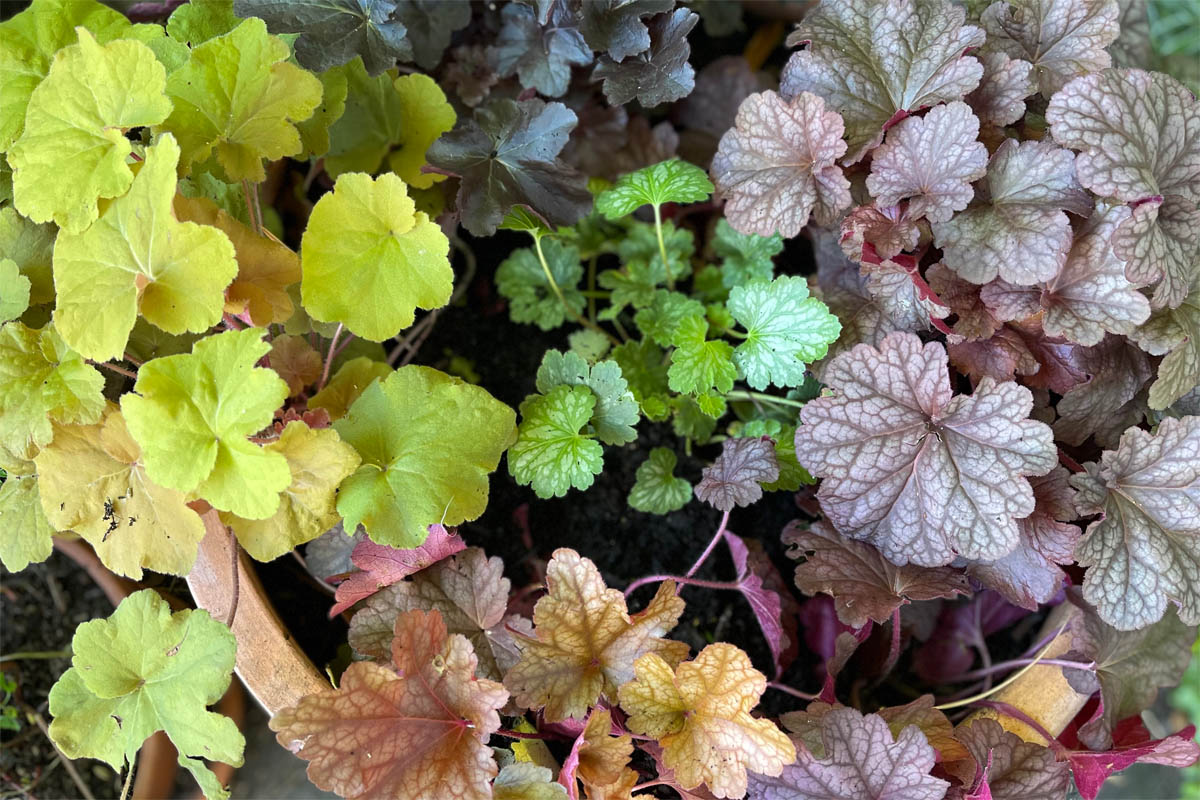
Heuchera really is the unsung hero of the plant world. It grows well in garden beds or pots, in shade or sun. With the rainbow of colours to create an eye-catching display. As a bonus, the delicate, bell-shaped flowers attract pollinators such as butterflies and bees.
- Ground cover: The low growth habit and dense clumps make Heuchera an ideal choice for ground cover in shaded or partially shaded areas.
- Border plantings: Heuchera makes the perfect border plant for edging along garden paths, they can be a standalone plant, or mixed with other plants such as Foamflower (Tiarella spp.), Siberian Bugloss (Brunnera macrophylla), Lungwort (Pulmonaria spp.) and Spotted Dead Nettle (Lamium maculatum).
- Ground cover: Heuchera forms dense, low-growing clumps of colourful foliage making them a great choice for shaded areas.
- Container gardening: Heuchera is well-suited for pots and window boxes. The pot or window box should have at least one drainage hole in the bottom. There’s the option to add one or multiple colours to a large pot for an eye-catching display. Choose a pot that is at least 2.5 cm wider than the root ball.
- Mass plantings: The vibrant foliage makes a stunning visual display when mass planted in garden beds.
- Woodland gardens: Due to their shade-loving tendencies, Heuchera is the ideal woodland plant as it thrives under the canopy of trees and provides a variety of foliage, textures and colours. Complimentary plants include Goat’s Bears (Aruncus dioicus), Wood Anemone (Anemone nemorosa), Solomon’s Seal (Polygonatum spp.), Wild Ginger (Asarum spp.), and Virginia Bluebells (Mertensia spp.)
- Rock gardens: Some Heuchera species are native to rocky habitats, making them a suitable choice for rock gardens or areas with poor, well-draining soil. Look out for H. parviflora, H. sanguine, H. cylindrica and H. micrantha.
- Vertical Gardens: Incorporating Heuchera into a stunning display can be achieved by selecting either a single colour or multiple contrasting varieties for a vertical garden. I have recently embarked on this project to create a vertical wall. We installed a sturdy metal frame and attached vertical wall pots to grow an assortment of colourful Heuchera cultivars. While the arrangement is still a work in progress (we need over 100 plants), I continue to search for unique colours to add to the collection. Plants on Walls has some beautiful examples of Heuchera on a vertical wall. Total Landscape Care also has a stunning example of a vertical wall with contrasting Heuchera colours.
Propagation
Heuchera is propagated via division, cuttings or seed. It is best to wait until early spring before you divide.
Division
- Remove the plant from the pot or ground, make sure you get as much of the root system as possible. Carefully shake off excess soil.
- Using a sharp clean knife, separate the plant into smaller sections, ensuring each section has a healthy shoot and roots.
- Trim away any dead or damaged leaves from the individual sections.
- Replant into a new pot or garden bed.
- Water in well.
- Protect from direct sunlight until the plant is well established.
Note: It is also possible to divide and root the plant in water. Once the root system is established, transfer to a pot with a premium potting mix.
Cuttings
Cuttings should be taken during the active growing period of late spring to early summer.
- Select healthy, vigorous growth from the base of the plant with new shoots with leaves.
- Use a clean, sharp knife and carefully cut a shoot-off at the base where it meets the crown.
- Fill a clean pot with a well-draining potting mix and moisten.
- Use a pencil or twig to make a hole where the cutting will go.
- Remove the lower leaves, leaving only the top two. Dip the end in rooting hormone (optional), and carefully insert the cutting 2.5 cm deep into the potting mix. Gently firm the soil around the cutting.
- Cover the pot with a clear plastic bag or cut-up soft drink bottle to maintain humidity.
- Place the pot in a warm location with bright, indirect light and maintain moisture levels. The soil should be moist, but not saturated.
- Roots should develop within 3-4 weeks. Transplant when the cutting has a well-developed root system.
Growing from seed
Heuchera seeds are not widely available commercially, but it is possible to collect seeds from your own plant. The offspring will differ from the parent plant. Seeds are ready to harvest once the flower head has turned brown and dry in late autumn (fall).
- Run your hand along the heuchera stalk to gently remove the seed heads.
- Place in a paper bag and allow to dry, which should take several weeks.
- Once the seed heads are dry, carefully crush them to release the seeds.
- Separate the seeds from any remaining plant matter by sifting them with a mesh strainer and storing them until spring.
- Prepare a tray with seedling mix, and sow the seeds on top of the mix. Heuchera seeds need light to germinate, so do not cover them.
- Use a spray bottle/mister to lightly moisten the soil. Keep moist until the seedlings emerge in 2-3 weeks.
- Once the seedlings are 2.5 cm high, they can be transplanted to a pot or into the ground.
Toxicity
Non-toxic to humans, dogs, cats and horses.
Julia is a writer and landscape consultant from Wollongong with a love of horticulture. She had been an avid gardener for over 30 years, collects rare variegated plants and is a home orchardist. Julia is passionate about learning and sharing her knowledge of plant propagation and plant toxicology. Whether it’s giving advice on landscape projects or sharing tips on growing, Julia enjoys helping people make their gardens flourish.
